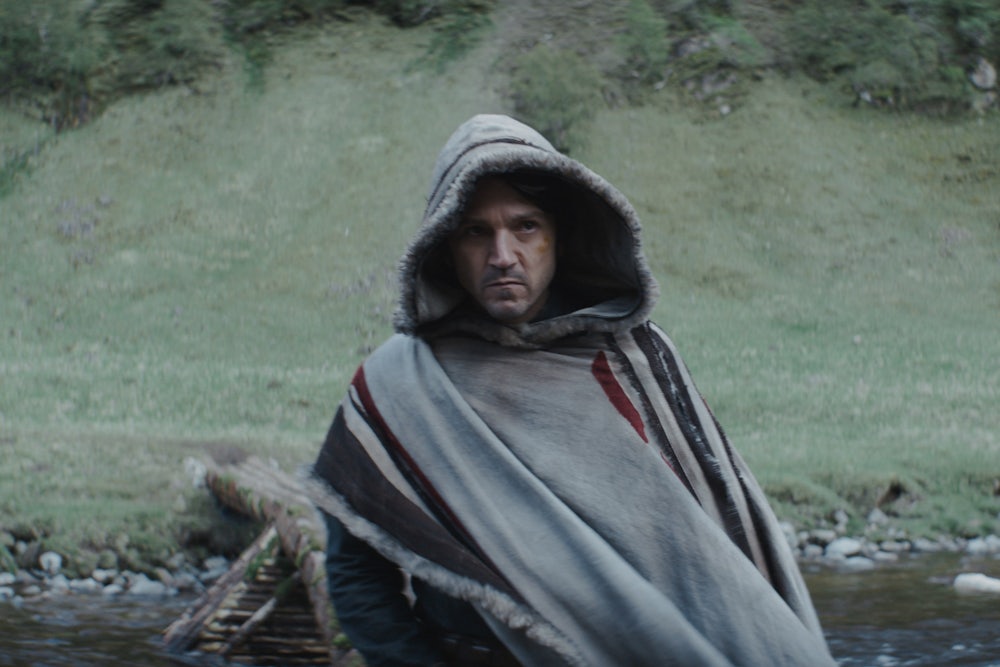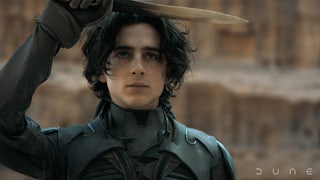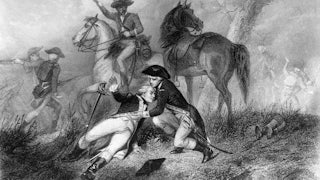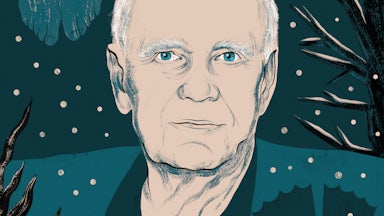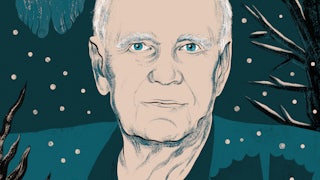There are no lightsabers in the first episode of Andor—no Jedi, no Sith, and no references to the Force. There are no Imperial officers or stormtroopers, nor anyone explicitly identified as part of the Rebel Alliance; there are no TIE Fighters or X-Wings. There are almost no aliens; there is one droid, but it’s the worst-functioning, least gracefully designed droid imaginable, and the first thing we see it do is get used as a hydrant by a stray four-legged beast. There are no space battles, and other than a brief fatal skirmish between three men in an alley outside a brothel, there’s no action at all. There’s no Wagnerian John Williams score to tell us how to feel about each character, and besides the titular protagonist, Cassian Andor (Diego Luna), whom fans may dimly recall from the 2016 standalone film Rogue One, there isn’t anyone we’ve ever met before.
Some of those missing elements gradually make appearances in the 11 episodes that follow, and some do not. We are in the Star Wars universe, and if you look carefully, you can recognize the aesthetic signatures of the 45-year-old franchise in the tailoring of an outfit, the design of a doorway, and the ubiquitous, rusty, analog technology—but otherwise, the methodically paced Andor asks us to trust that this is all headed somewhere more familiar. Those in search of video game cutscenes, fan service, and Easter eggs already have many hours of recent Star Wars properties to select from; Andor instead offers intelligent dialogue, political and moral complexity, and actors channeling believable human behavior on physical sets.
In 1977, Pauline Kael described the original Star Wars (now more often referred to as Episode IV: A New Hope) as “like getting a box of Cracker Jack which is all prizes,” sniffing that “the excitement of those who call it the film of the year goes way past nostalgia to the feeling that now is the time to return to childhood.” In 2017, that film’s writer and director, George Lucas, affirmed that Star Wars had always been intended for 12-year-olds. “Friendships, honesty, trust, doing the right thing, living on the right side and avoiding the dark side,” were the values Lucas meant to impart to a young audience, he told a fan convention, five years after he sold the franchise to the family-friendly Disney corporation for $4 billion. But even if Star Wars was always meant for kids and was always understood as such by its least generous critics, several generations of those kids have grown up still caring about it as adults and still expecting it to mean something in an adult world. When Ronald Reagan called the Soviet Union an “evil empire” and proposed fighting it with a space-based missile defense system dubbed “Star Wars,” when liberals mobilizing against Donald Trump proclaimed themselves “the Resistance,” or when bestselling author Michael Lewis pitched his forthcoming book on the feud between Sam Bankman-Fried and his rival Changpeng Zhao as portraying “the Luke Skywalker and Darth Vader of crypto,” it spoke to the relevance of Star Wars to contemporary adults. In that way, Kael was right that those adults have never left childhood behind.
But Andor is something new and astonishing: a Star Wars series written and filmed entirely for discerning grown-ups. It’s accurate but faint praise to call this the smartest Star Wars ever made; it’s one of the smartest shows anyone has made in recent years, and can reasonably be mentioned in the same breath as, say, The Wire. It’s better than this bloated and wildly uneven franchise deserves; that it was greenlit at all suggests, against all odds, that even endlessly recycled blockbuster intellectual properties have some room for artistry.
If Lucas offered a child’s black-and-white understanding of morality to an audience of children (and children at heart), Andor is a show about the moral choices adults are forced to make in a world of adult consequences. More specifically, it’s a show about the choices adults make against a backdrop of fascism. Fascism has always been present in Star Wars—an obvious inspiration both for the design of Imperial uniforms and for the Riefenstahl-esque Rebel victory ceremony that closes out A New Hope—but World War II imagery was just part of the collage of influences Lucas was assembling from the films of his youth, along with Westerns, samurai movies, and Flash Gordon serials. The Empire may massacre Luke Skywalker’s adopted family, and it may destroy Princess Leia’s homeworld to terrorize other planets into submission, but Mark Hamill and Carrie Fisher each spend at most 30 seconds reacting to those atrocities before they’re back to quipping.
That’s the nature of Star Wars as we’ve known it, and it has often worked on its own terms, but for fans who have wondered what actual humans might do when confronted with the Empire’s totalitarian savagery, Andor is an extended response. Its cinematic influences are less adventure genres and more John le Carré and The Battle of Algiers. The show’s creator, Tony Gilroy, is best known for scripting the Jason Bourne espionage thrillers; his previous Star Wars experience consisted of being brought in by Disney to punch up Rogue One, an immediate prequel to A New Hope that focused on the ordinary Rebels who fought and sacrificed to get the Death Star plans into the hands of Princess Leia. Andor is a much deeper exploration of that theme, with sharper writing and more fully developed characters; seemingly everyone with a line of dialogue is given a three-dimensional personality, plausible motivations, and a degree of human dignity.
When we first meet Cassian Andor, five years before the events of A New Hope, all we know about him is that he’s searching for a long-lost sister. A backstory emerges in flashbacks; he grew up in what resembles an Indigenous Amazonian tribe in the jungle world of Kenari, which suffered an apocalyptic injustice when he was a child; as an adult, he lives with his adoptive mother on Ferrix, a mining planet defined by a close-knit community of blue-collar workers, where he seems to owe everyone money or a favor. Cassian is a kind but cynical petty thief, and aside from a small number of interpersonal loyalties, nothing seems to orient him. Like all decent people, he hates the Empire, but the Empire is distant and mostly leaves Ferrix alone to govern its own affairs—or, when Cassian stirs up trouble, to be pushed around by the poorly equipped and trained security forces of the private corporation profiting off all the mining.
But the galaxy is bigger than Ferrix, and so is Andor—and as the show widens its aperture, we come to see how Cassian’s story fits into the galactic civil war that’s fully underway by A New Hope but still nascent at this point. One by one, we meet characters who are grappling with what it means either to rebel against or to conform to a fascist political order, from the top of society to the bottom and from the Imperial core to the most remote outlying planets. There’s Luthen Rael (Stellen Skarsgård), a world-weary Rebel operative willing to make profound moral sacrifices to accelerate the Empire’s reckoning. There’s Dedra Meero (Denise Gough), an ice-hearted Imperial intelligence analyst who is more ruthlessly competent than any of her condescending male colleagues—which might tempt us to root for her, until we remember that her goal is to capture and psychologically break the Rebels. There’s Mon Mothma (Genevieve O’Reilly), who was briefly introduced as the leader of the Rebel Alliance in 1983’s Return of the Jedi, but who is fleshed out in Andor as a glamorous, unhappily married, lonely liberal reformer in Emperor Palpatine’s rubber-stamp Senate—one who is quietly raiding her family trust fund to finance a violent insurgency against the Empire, carried out in part by her Bernardine Dohrn-esque cousin Vel (Faye Marsay). There’s Syril Karn (Kyle Soller), a lowly corporate security apparatchik with the pretensions of an Imperial officer and with simmering, repressed rage instilled by a tyrannical nag of a mother. Those are just the most memorable, though I’d be remiss if I didn’t mention Andy Serkis’s wrenching performance as a prison camp kapo.
The planetary settings are every bit as carefully thought out as the characters. Over the course of the season, we visit the mountainous world of Aldhani, whose natives gather periodically under Imperial military supervision to witness a religiously inspiring interstellar phenomenon; a Miami-like resort world called Niamos where the wrong look can lead to arbitrary arrest and sentencing; a dystopian offshore prison colony on a watery world called Narkina 5, where the Empire exploits inmates for industrial-scale slave labor; and both the heights and depths of the fully urbanized Imperial capital of Coruscant, which we’ve seen before but which is rendered here with the brutalism of a 1970s spy drama. From the beginning, the Star Wars universe has drawn praise for its “lived-in” feel, but never has it felt more richly inhabited by complex societies marked by disparities in wealth, power, and status. What we see feels consistent with Star Wars as we’ve previously understood it but at the same time fresh and specific—the Empire isn’t static, and the precise ways it operates and expands its suffocating order are made legible as never before. So too are the ways its subjects resist it.
What makes a rebel, and what makes a revolution? As the historian Mike Duncan has been detailing in the most recent episodes of his podcast Revolutions, the existence of an oppressive regime doesn’t necessarily imply its overthrow by a righteously aggrieved populace. Most revolutions fail; indeed, most never get off the ground. “The more you tighten your grip,” Princess Leia tells Grand Moff Tarkin in A New Hope, “the more star systems will slip through your fingers.” That’s a coherent but insufficient account of how a rebellion powerful enough to threaten the Empire’s legitimacy might come about; what Andor offers is a step-by-step guide to revolution anchored in real historical uprisings of the past two centuries and germane to our own increasingly illiberal present. You need angry mobs, yes—but you also need well-placed elites willing to take major risks to move money and weapons around; double agents embedded in the highest echelons of the national security state; and skilled military commandos willing to rob banks, to take innocent children hostage, to work with amoral mercenaries, and possibly to kill them when they know too much. Sometimes you stage an action intended to heighten the contradictions, knowing full well that innocent people will be slaughtered in the reprisals. Revolutions are never clean, and the regimes they overthrow, however cruel, have their own loyal constituents well beyond the centers of power, including a certain kind of damaged personality that thrives on order and predictability. Sometimes the Empire is hard to distinguish, morally or aesthetically, from the United States at the height of the “war on terror”—and sometimes the Rebels are similarly hard to distinguish from terrorists.
These aren’t the sorts of insights one expects to find on the streaming service that also carries Marvel’s Eternals and season 34 of The Simpsons, but somehow, Gilroy has persuaded Disney to let him tease out the underlying politics of Star Wars at his own speed and with full respect for his audience’s intelligence. Andor is worth watching even if you hate Star Wars, or if you’ve never seen it at all.
